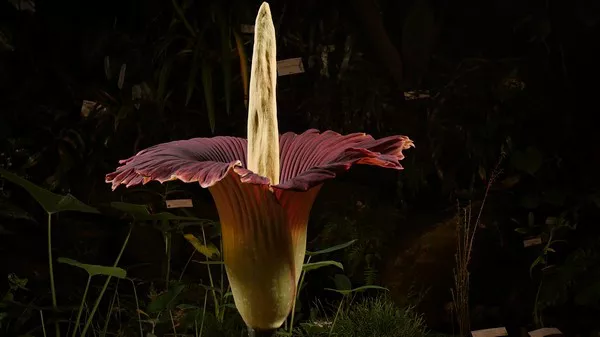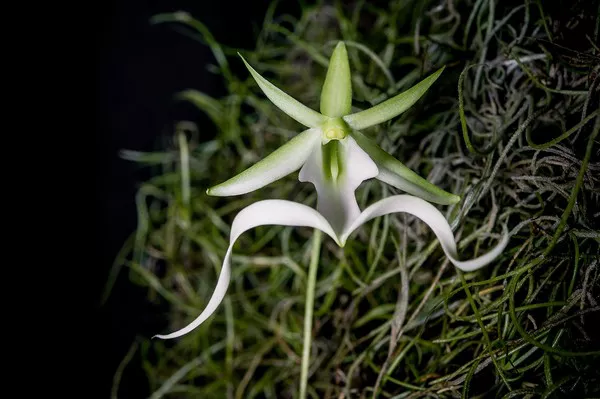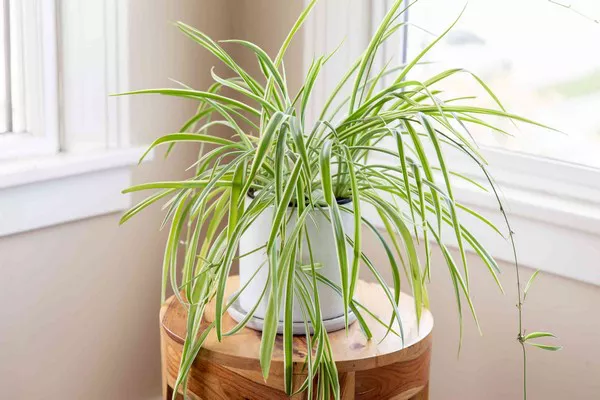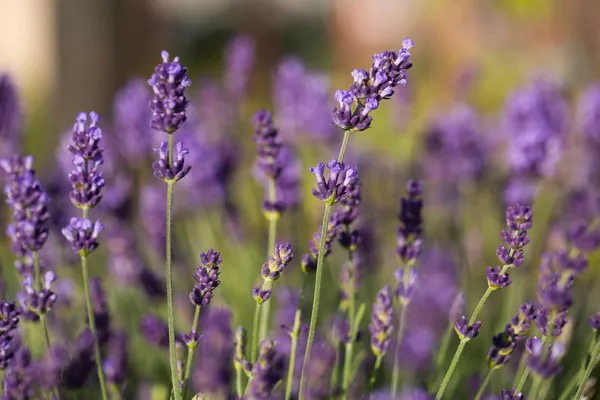From the lush rainforests of the Amazon to the arid deserts of Africa, the world is home to a stunning array of exotic flowers that captivate with their beauty, diversity, and unique adaptations. These botanical marvels come in all shapes, sizes, and colors, each with its own fascinating story to tell. In this comprehensive guide, we embark on a journey to explore the world’s 15 most exotic flowers, uncovering their extraordinary features, habitats, and cultural significance.
World’s 15 Most Exotic Flowers
1. Corpse Flower (Amorphophallus titanum)

The corpse flower, also known as titan arum, is one of the largest and most unusual flowers in the world. Native to the rainforests of Sumatra, Indonesia, this monstrous plant is famous for its distinctive odor, which resembles that of rotting flesh.
The corpse flower’s inflorescence can reach heights of up to ten feet and is composed of a tall spadix surrounded by a large, leaf-like spathe. The plant blooms infrequently, sometimes taking several years to produce a single flower, which lasts only a few days before withering away.
Despite its unpleasant scent, the corpse flower attracts pollinators such as flies and beetles, which are drawn to the odor and help to pollinate the plant. Conservation efforts are underway to protect the remaining populations of this rare and remarkable species, which is threatened by habitat loss and deforestation.
See Also: Unveiling the Largest Carnivorous Flower – Titan Arum!
2. Ghost Orchid (Dendrophylax lindenii)

The ghost orchid is a rare and elusive flower found in the swamps and forests of Florida and Cuba. Named for its ghostly appearance and ethereal beauty, this orchid is known for its delicate white flowers and long, slender roots that dangle from tree branches.
The ghost orchid blooms sporadically throughout the year, with each flower lasting only a few weeks before fading away. It is pollinated primarily by nocturnal moths, which are attracted to its fragrant scent and pale petals.
Due to its specialized habitat requirements and limited range, the ghost orchid is considered endangered and is protected by law in both the United States and Cuba. Conservation efforts, including habitat restoration and monitoring programs, are helping to ensure the survival of this rare and enchanting species.
See Also: 15 Most Rare Orchids in the World
3. Jade Vine (Strongylodon macrobotrys)
The jade vine is a rare and exquisite flower native to the rainforests of the Philippines. Known for its stunning turquoise-colored flowers and long, cascading vines, this plant is a favorite among botanists and horticulturalists around the world.
The jade vine blooms in clusters of delicate flowers, which hang in long, pendulous racemes and resemble strings of jade beads. It is pollinated primarily by bats and birds, which are attracted to its vibrant color and sweet nectar.
Habitat loss and deforestation pose serious threats to the jade vine, which is classified as endangered due to declining populations in its native range. Conservation efforts, including habitat protection and propagation programs, are underway to save this rare and beautiful species from extinction.
4. Rafflesia (Rafflesia arnoldii)
The rafflesia is a rare and bizarre flower found in the rainforests of Southeast Asia. Known for its massive size and foul odor, this parasitic plant is famous for producing the largest flowers in the world.
The rafflesia’s flowers can measure up to three feet in diameter and weigh as much as 24 pounds, making them some of the largest and heaviest blooms on the planet. Despite their impressive size, rafflesia flowers are short-lived, lasting only a few days before decaying into a foul-smelling mush.
The rafflesia is pollinated by flies and beetles, which are attracted to its odor and help to transfer pollen between flowers. Despite its unique adaptations and ecological importance, the rafflesia is threatened by habitat loss and deforestation, which are destroying its rainforest habitat.
Conservation efforts, including habitat protection and community-based conservation initiatives, are critical for the survival of the rafflesia and other endangered species in Southeast Asia’s rainforests.
5. Queen of the Night (Selenicereus grandiflorus)
The queen of the night is a rare and ephemeral flower native to the deserts of the Americas. Known for its nocturnal blooming habit and intoxicating fragrance, this elusive plant is a favorite among cactus enthusiasts and gardeners.
The queen of the night blooms only once a year, typically on warm summer nights, and its flowers last for just a few hours before wilting away. Despite their short-lived nature, the flowers are prized for their delicate beauty and sweet scent, which fills the night air with perfume.
The queen of the night is pollinated by nocturnal insects, such as moths and bats, which are attracted to its scent and nectar. Despite its cultural significance and horticultural value, the queen of the night is threatened by habitat loss and illegal collection, which are impacting wild populations in its native range.
Conservation efforts, including habitat restoration and propagation programs, are underway to protect this rare and enchanting species and ensure its survival for future generations to enjoy.
6. Lady’s Slipper Orchid (Cypripedium calceolus)
The lady’s slipper orchid is a rare and beautiful flower found in temperate forests and meadows around the world. Known for its distinctive slipper-shaped pouch and delicate blooms, this orchid is prized by collectors and botanists for its beauty and rarity.
The lady’s slipper orchid is pollinated by bees and other insects, which are attracted to its sweet scent and colorful flowers. Despite its popularity, the orchid is threatened by habitat loss, illegal collection, and climate change, which are impacting wild populations in many parts of its range.
Conservation efforts, including habitat protection and reintroduction programs, are underway to protect the lady’s slipper orchid and ensure its survival for future generations to enjoy.
7. Parrot’s Beak (Lotus berthelotii)
The parrot’s beak is a rare and unusual flower native to the Canary Islands and Madeira. Known for its distinctive beak-like shape and vibrant orange-red color, this plant is a favorite among gardeners and horticulturalists for its unique appearance.
The parrot’s beak blooms profusely throughout the year, producing clusters of small, tubular flowers that resemble the beak of a parrot. It is pollinated by birds and insects, which are attracted to its bright color and sweet nectar.
Despite its popularity in cultivation, the parrot’s beak is threatened in its native habitat by habitat loss, invasive species, and climate change. Conservation efforts, including habitat restoration and protection, are crucial for ensuring the survival of this rare and beautiful flower in the wild.
8. Black Bat Flower (Tacca chantrieri)
The black bat flower is a rare and striking plant native to the rainforests of Southeast Asia. Known for its bizarre appearance and unique floral structure, this plant is named for its dark, bat-like flowers that hang in clusters from long stalks.
The black bat flower blooms sporadically throughout the year, with each flower lasting only a few days before fading away. It is pollinated by flies and beetles, which are attracted to its foul odor and dark coloration.
Despite its unusual appearance, the black bat flower is prized by collectors and botanists for its beauty and rarity. Habitat loss and deforestation pose serious threats to this species, which is classified as endangered due to declining populations in its native range.
Conservation efforts, including habitat protection and propagation programs, are underway to save the black bat flower from extinction and ensure its survival for future generations to admire.
9. Himalayan Blue Poppy (Meconopsis betonicifolia)
The Himalayan blue poppy is a rare and exquisite flower native to the mountainous regions of Asia. Known for its stunning blue petals and delicate appearance, this plant is a favorite among gardeners and flower enthusiasts for its beauty and rarity.
The Himalayan blue poppy blooms in late spring and early summer, producing large, cup-shaped flowers that can measure up to six inches in diameter. It is pollinated by bees and other insects, which are attracted to its vibrant color and sweet nectar.
Despite its popularity in cultivation, the Himalayan blue poppy is difficult to grow outside of its native habitat due to its specialized environmental requirements. Habitat loss and climate change pose additional threats to this species, which is classified as endangered in some parts of its range.
Conservation efforts, including habitat protection and propagation programs, are underway to save the Himalayan blue poppy from extinction and ensure its survival for future generations to enjoy.
10. Rainbow Eucalyptus (Eucalyptus deglupta)
The rainbow eucalyptus is a rare and remarkable tree native to the rainforests of Indonesia, Papua New Guinea, and the Philippines. Known for its striking multicolored bark and towering height, this tree is a favorite among photographers and nature enthusiasts for its surreal beauty.
The rainbow eucalyptus sheds its outer bark annually, revealing a vibrant palette of colors ranging from green to orange, purple, and blue. This unique adaptation is thought to help protect the tree from insects and diseases while also providing camouflage in the dense rainforest.
Despite its stunning appearance, the rainbow eucalyptus is threatened by habitat loss and deforestation, which are destroying its rainforest habitat. Conservation efforts, including habitat protection and reforestation programs, are crucial for ensuring the survival of this rare and magnificent tree.
11. Night-Blooming Cereus (Epiphyllum oxypetalum)
The night-blooming cereus is a rare and mysterious flower native to the deserts of the Americas. Known for its nocturnal blooming habit and intoxicating fragrance, this plant is a favorite among gardeners and flower enthusiasts for its beauty and rarity.
The night-blooming cereus blooms only once a year, typically on warm summer nights, and its flowers last for just a few hours before wilting away. Despite their short-lived nature, the flowers are prized for their delicate beauty and sweet scent, which fills the night air with perfume.
The night-blooming cereus is pollinated by nocturnal insects, such as moths and bats, which are attracted to its scent and nectar. Despite its cultural significance and horticultural value, the night-blooming cereus is threatened by habitat loss and illegal collection, which are impacting wild populations in its native range.
Conservation efforts, including habitat restoration and propagation programs, are underway to protect this rare and enchanting species and ensure its survival for future generations to enjoy.
12. Cannonball Tree (Couroupita guianensis)
The cannonball tree is a rare and unusual tree native to the rainforests of South America and the Caribbean. Known for its large, round fruits and fragrant flowers, this tree is a favorite among gardeners and botanists for its beauty and unique appearance.
The cannonball tree produces clusters of large, round fruits that resemble cannonballs, giving the tree its common name. Its flowers are equally impressive, with large, colorful petals and a sweet, tropical fragrance that attracts pollinators such as bees and butterflies.
Despite its beauty and cultural significance, the cannonball tree is threatened by habitat loss and deforestation, which are destroying its rainforest habitat. Conservation efforts, including habitat protection and reforestation programs, are crucial for ensuring the survival of this rare and magnificent tree.
13. Bee Orchid (Ophrys apifera)
The bee orchid is a rare and intriguing flower native to Europe, North Africa, and the Middle East. Known for its uncanny resemblance to a bee in flight, this orchid is a favorite among botanists and orchid enthusiasts for its unique appearance and unusual pollination strategy.
The bee orchid produces flowers that closely resemble female bees, complete with fuzzy brown petals and a yellow “landing pad” that mimics the bee’s abdomen. Male bees are attracted to the flowers and attempt to mate with them, inadvertently transferring pollen in the process.
Despite its clever adaptation, the bee orchid is threatened by habitat loss and disturbance, which are impacting wild populations in its native range. Conservation efforts, including habitat protection and propagation programs, are underway to protect this rare and remarkable species and ensure its survival for future generations to enjoy.
14. Monkey Face Orchid (Dracula simia)
The monkey face orchid is a rare and whimsical flower native to the cloud forests of Ecuador and Peru. Known for its striking resemblance to a monkey’s face, this orchid is a favorite among orchid enthusiasts and nature lovers for its unique appearance and playful charm.
The monkey face orchid blooms with small flowers that indeed bear a striking resemblance to the face of a monkey, complete with eyes, nose, and even ears. This uncanny resemblance has earned it its common name and made it a sought-after specimen among collectors and enthusiasts.
Due to its specialized habitat requirements and limited distribution in the cloud forests of South America, the monkey face orchid is considered rare and threatened. Habitat loss and fragmentation, as well as illegal collection for the horticultural trade, pose significant threats to its survival in the wild.
Conservation efforts, including habitat protection, research, and education initiatives, are essential for safeguarding the monkey face orchid and its fragile ecosystem. By raising awareness about the importance of preserving cloud forests and their unique biodiversity, we can help ensure the survival of this rare and enchanting flower.
See Also: 10 Most Interesting Plants in the World
15. Black Bat Lily (Tacca integrifolia)
The black bat lily is a rare and mysterious flower native to the tropical forests of Southeast Asia. Known for its bizarre appearance and unique floral structure, this plant is a favorite among collectors and enthusiasts for its striking beauty and unusual form.
The black bat lily produces large, dark purple flowers that resemble bats in flight, with long, slender “whiskers” extending from the center. These unusual blooms are pollinated by bats and other nocturnal creatures, which are attracted to their scent and nectar.
Despite its popularity in cultivation, the black bat lily is threatened by habitat loss and deforestation, which are destroying its rainforest habitat. Conservation efforts, including habitat protection and propagation programs, are crucial for ensuring the survival of this rare and magnificent flower in the wild.
See Also: The 15 Rarest Flowers in the World
Conclusion
Exotic flowers are nature’s masterpieces, each with its own unique beauty, adaptations, and ecological significance. From the rainforests of the Amazon to the deserts of Africa, these botanical marvels captivate the imagination and inspire awe with their stunning colors, shapes, and fragrances.
However, many exotic flowers are facing unprecedented threats from habitat loss, deforestation, climate change, and illegal collection. Conservation efforts are essential for protecting these rare and remarkable species and ensuring their survival for future generations to enjoy.
By raising awareness about the importance of preserving biodiversity and protecting fragile ecosystems, we can help safeguard the world’s most exotic flowers and the habitats they call home. Through collaboration, education, and sustainable practices, we can work together to conserve these botanical treasures and celebrate the beauty and diversity of nature.
You Might Be Interested In:





![10 Most Richest Cities in the United States [Revealed!]](https://www.validdownloads.com/wp-content/uploads/2023/12/Manjula-Pothos.webp)



















